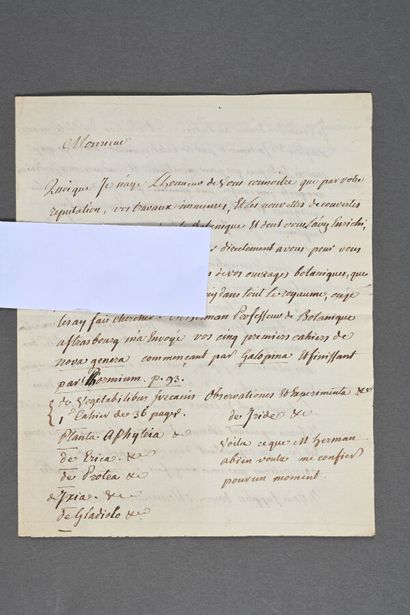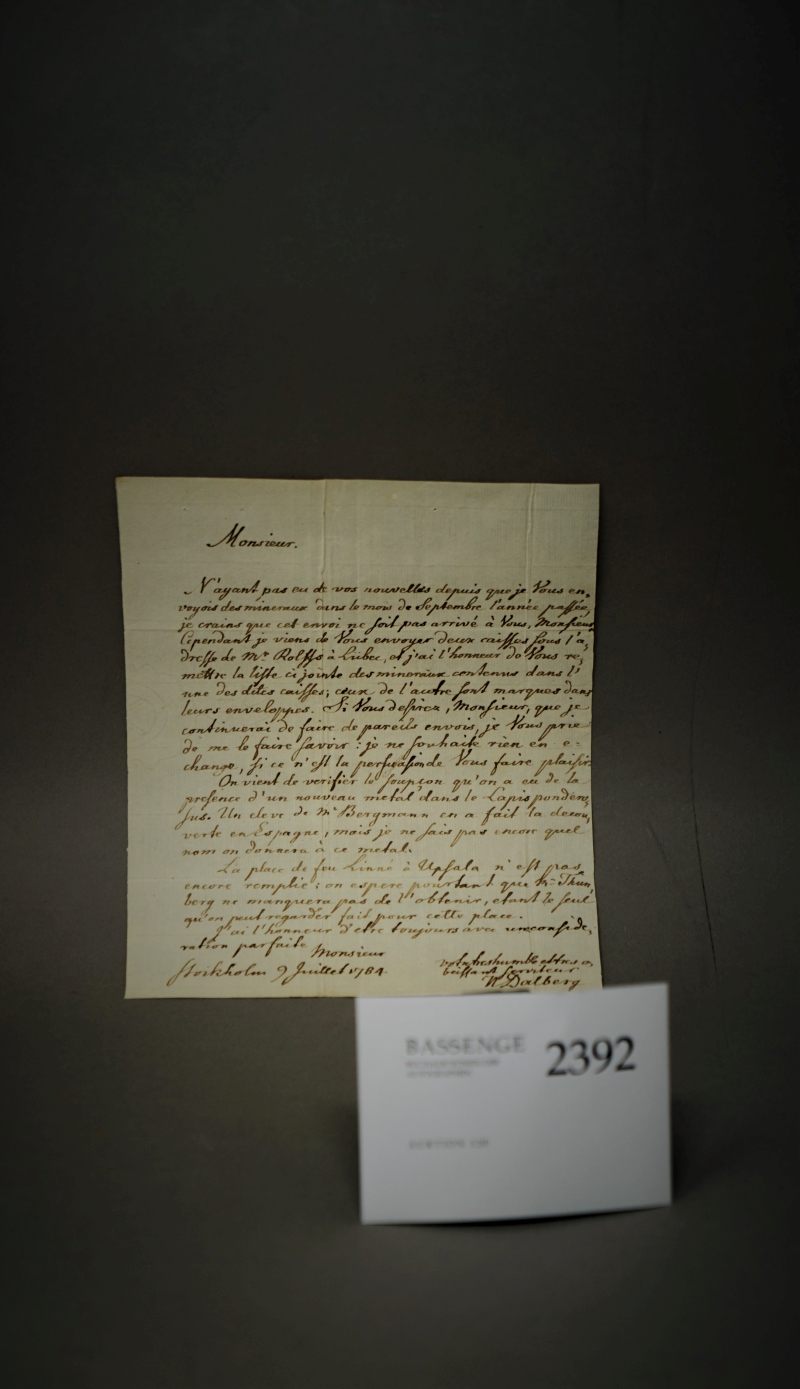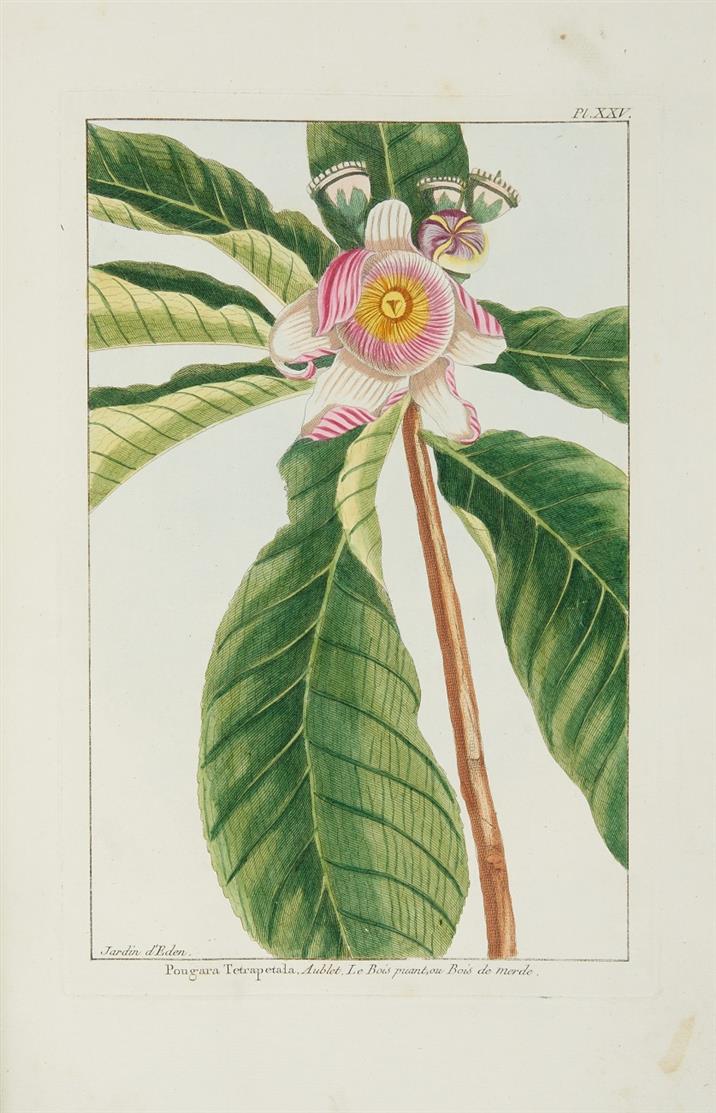CARL PETER THUNBERG (1743-1828) Voyages ... au Japon , translated and edited by L. Langlès, natural history sections edited by J.B. Lamarck. Paris: Benoit Dandré, Garnèry, Obré, 1796. 2 volumes, 4° (250 x 193mm). Engraved frontispiece portrait and 28 plates. Half-titles. A few quires printed on blue paper. (Some browning, occasional marginal tears, M3 of vol. I with paper fault at margin, small waterstain in vol. II.) Contemporary polished Parisian calf by Jean-Baptiste Gosselin, with his ticket in vol. I, covers with elaborate gilt fillet and roll-tool borders, floral corner-pieces, gilt spine compartments with red morocco lettering-pieces and bands, gilt inner dentelles, pink marbled endpapers, gilt edges (extremities lightly rubbed, light scuff marks). A FINELY BOUND COPY OF THE QUARTO EDITION BY GOSSELIN. A favourite pupil of Linnaeus, Thunberg was sent on a mission to the Cape of Good Hope, Java, Japan and Ceylon on behalf of the Botanical Garden of Amsterdam. Since Japan was only open to Dutch merchants, the Swedish naturalist spent three years in Cape Colony learning Dutch, and making several expeditions into the interior in search of plant specimens, before sailing for Java in March 1775. In August he finally arrived at the Dutch factory of the VOC at Dejima, a small artificial island connected to Nagasaki by a landfill. Appointed head surgeon of this trading post, he was denied any opportunity to travel further until mid 1776 when he accompanied the director of the settlement to the shogun in Edo (modern Tokyo). He left Japan in November 1776. Flora Japonica was published at Leipzig in 1784, and followed rather tardily by an account of his travels in Swedish (Uppsala, 1788-93). The French edition of 1796 was published in both 4 volumes 8vo., like the Swedish edition, and 2 volumes 4to. Volume II of the latter includes chapters on the character and religion of the Japanese, their language and customs, the zoology of Japan, minerals, food, festivals, agriculture, the calendar, science and arts. The binder's ticket in this copy gives Gosselin's address as rue Saint-Jacques, No. 49 à Paris, but the number of the house has been altered in ms from 49 to 41. Brunet V, 850; Cordier Japan 447; Landwehr VOC 344; Mendelssohn II, p. 499. (2)
CARL PETER THUNBERG (1743-1828) Voyages ... au Japon , translated and edited by L. Langlès, natural history sections edited by J.B. Lamarck. Paris: Benoit Dandré, Garnèry, Obré, 1796. 2 volumes, 4° (250 x 193mm). Engraved frontispiece portrait and 28 plates. Half-titles. A few quires printed on blue paper. (Some browning, occasional marginal tears, M3 of vol. I with paper fault at margin, small waterstain in vol. II.) Contemporary polished Parisian calf by Jean-Baptiste Gosselin, with his ticket in vol. I, covers with elaborate gilt fillet and roll-tool borders, floral corner-pieces, gilt spine compartments with red morocco lettering-pieces and bands, gilt inner dentelles, pink marbled endpapers, gilt edges (extremities lightly rubbed, light scuff marks). A FINELY BOUND COPY OF THE QUARTO EDITION BY GOSSELIN. A favourite pupil of Linnaeus, Thunberg was sent on a mission to the Cape of Good Hope, Java, Japan and Ceylon on behalf of the Botanical Garden of Amsterdam. Since Japan was only open to Dutch merchants, the Swedish naturalist spent three years in Cape Colony learning Dutch, and making several expeditions into the interior in search of plant specimens, before sailing for Java in March 1775. In August he finally arrived at the Dutch factory of the VOC at Dejima, a small artificial island connected to Nagasaki by a landfill. Appointed head surgeon of this trading post, he was denied any opportunity to travel further until mid 1776 when he accompanied the director of the settlement to the shogun in Edo (modern Tokyo). He left Japan in November 1776. Flora Japonica was published at Leipzig in 1784, and followed rather tardily by an account of his travels in Swedish (Uppsala, 1788-93). The French edition of 1796 was published in both 4 volumes 8vo., like the Swedish edition, and 2 volumes 4to. Volume II of the latter includes chapters on the character and religion of the Japanese, their language and customs, the zoology of Japan, minerals, food, festivals, agriculture, the calendar, science and arts. The binder's ticket in this copy gives Gosselin's address as rue Saint-Jacques, No. 49 à Paris, but the number of the house has been altered in ms from 49 to 41. Brunet V, 850; Cordier Japan 447; Landwehr VOC 344; Mendelssohn II, p. 499. (2)














Try LotSearch and its premium features for 7 days - without any costs!
Be notified automatically about new items in upcoming auctions.
Create an alert